Estimating an Augmented Reality App Development Cost
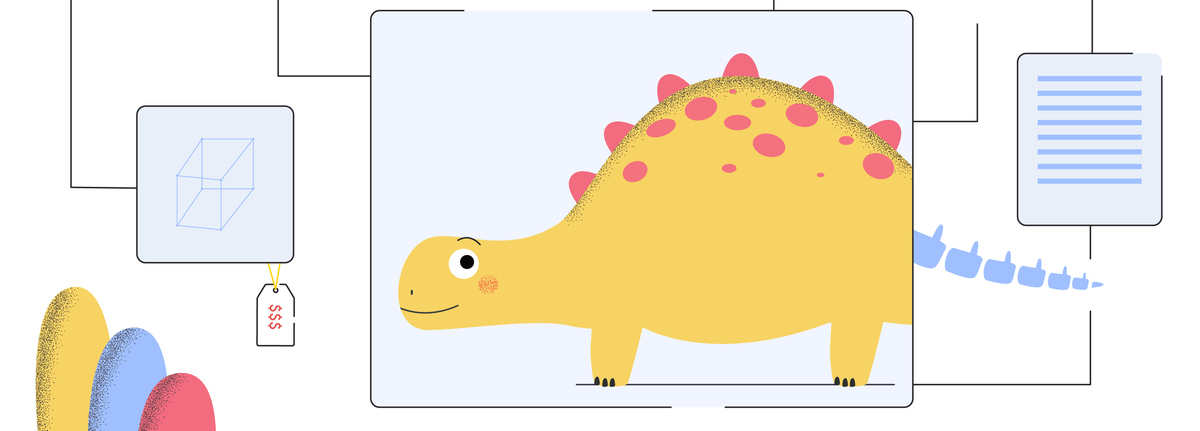
The augmented reality market is growing. In 2019, the active installed base reportedly approached 900 million, and revenue exceeded $8 billion. The same indicators are expected to reach 2.5 billion and $60 billion, respectively, by 2024. Messaging-based mobile augmented reality is the major platform type now and in long-term forecasts. Advertising is likely to be the main revenue stream, with lots of adspend going towards sponsored and user-generated content like filters and lenses on multimedia social applications.
As the understanding of the medium’s potential is growing, so is the entrepreneurs’ desire to sponsor or create augmented reality apps. After Gucci, Ikea, Toyota, and other leaders have built their products, smaller companies are catching up. Augmented reality app development is most appealing to the gaming, healthcare, and engineering segments, but is worth exploring virtually for any other industry or branch of business.
If the idea ever occurred to you as well, you probably wondered: how much does augmented reality cost? This article covers the factors that determine augmented reality app development costs, estimates the time and cost to build several types of apps, and offers advice on how to save money. We’re focusing on mobile app-based AR as the most appealing platform.
Main Components of the Augmented Reality App Development Cost
Like with any other mobile app, the development cost may be calculated by multiplying the specialists’ rate by the time required to complete the project. Let’s take a look at the factors that determine these variables.
Factors that Influence the Time to Create an Augmented Reality App
The timeline of an AR app development varies depending on:
- The type and quality of the app’s AR content and functionalities.
- The number of your mobile app’s features, complexity of its logic, monetization model, requirements for the UX/UI design, and the amount of quality assurance and project management activities. The necessary APIs, servers, and databases will contribute to the cost. Moreover, the more complicated the app, the higher the number of unforeseen changes and technical challenges.
- Whether you are building it for the Apple App Store, Google Play (GP), or both app stores. For example, an app taking 4 hours to publish on GP will require 8 hours to deploy on the App Store. However, Android app development usually takes longer than iOS development, and therefore is more expensive.
- The competence and expertise of the development team. The more qualified the team, the faster they work, and fewer errors need fixes.
AR Functionality
AR features are the most expensive part of the development. AR relies on special algorithms and sensors that determine the position and orientation of the camera for the appropriate rendering of 3D graphics at a location. The accurate location of the graphic elements enables real-time interaction with 3D objects. The more complicated the coding, the more hours specialists will spend on it, and the higher the resulting app price.
Based on the underlying technology, there are three types of augmented reality applications:
Marker-based/markerless AR applications
Physical images called markers act as triggers for placing pre-programmed virtual content onto a device screen. A QR-code, icon, or another image can be a trigger. The user scans it with the device, the app recognizes it, and projects corresponding AR content, such as a piece of textual information, animation, or call-to-action.
Marker-based apps are the simplest and least-costly as compared to other AR apps. The cheapest option is to put easy-to-scan 2D tags with edges and corners on a surface, e.g., AR-enabled labels, business cards, or marketing materials.
Developers need about 160-176 hours to implement such marker-based technology.
AR apps may also employ markerless recognition technology, where artificial intelligence helps to recognize real-world objects like furniture items or faces without special markers.
Location-based AR apps
Through a mobile device’s camera, virtual objects are placed over real-time video of the user’s surroundings without any markers, using mobile location awareness capabilities instead. For this purpose, they collect data from the device’s GPS, accelerometer, gyroscope, magnetometer, digital compass, or other sensors. Such AR apps are most suitable for travelers, drivers, and open-world ‘gamers’. Pokemon Go is an iconic example.
AR apps can also scan real objects, create 3D models thereof, and then put the digital copies to cloud storage. 3D scanning technology is sensor-based too. Ikea Place is an example of this kind of apps. Interior designers, decorators, architects, engineers, and educators also appreciate such 3D simulations.
The integration of sensors makes AR experiences costlier to develop. For example, a GPS-based solution leveraging cellular communication and Wi-Fi connection takes about 550-650 hours.
Visual odometry/SLAM-based AR apps
SLAM stands for ‘simultaneous localization and mapping.’ This technology ensures the highest accuracy for imposing digital 3D objects on real ones and performing actions with them. Manufacturers of drones, self-driven vehicles, and robotics utilize this technique.
Since SLAM uses complex algorithms and multiple sensors at once, the development timeline may exceed 850 or up to 1,000 hours.
Interactive AR apps mixing virtual elements with physical objects and allowing real-life interactions with the user, e.g., using the touch screen, are most in demand. The features of AR visualization and interactions with virtual objects are limited only by your imagination. However, the more you want, the higher your AR app development budget is going to be.
Choice of SDK
The choice of SDK (Software Development Kit) may impact your budget in two ways. First, the right set of tools simplifies and speeds up your app development process and helps adapt the product to various operating platforms, thus saving the time/efforts and reducing the cost of future fixes and product improvements. Second, some SDKs are paid, which should be taken into account when calculating the final augmented reality app development cost.
Usually, it is the development team that selects the best technological stack for a project. The primary factors that influence their decision are:
- target operating platform
- support of the preferred programming language
- possibility and frequency of AR app updates
- monetization strategy and licenses
Below, you can see some of the popular options suitable both for iOS and Android AR app development:
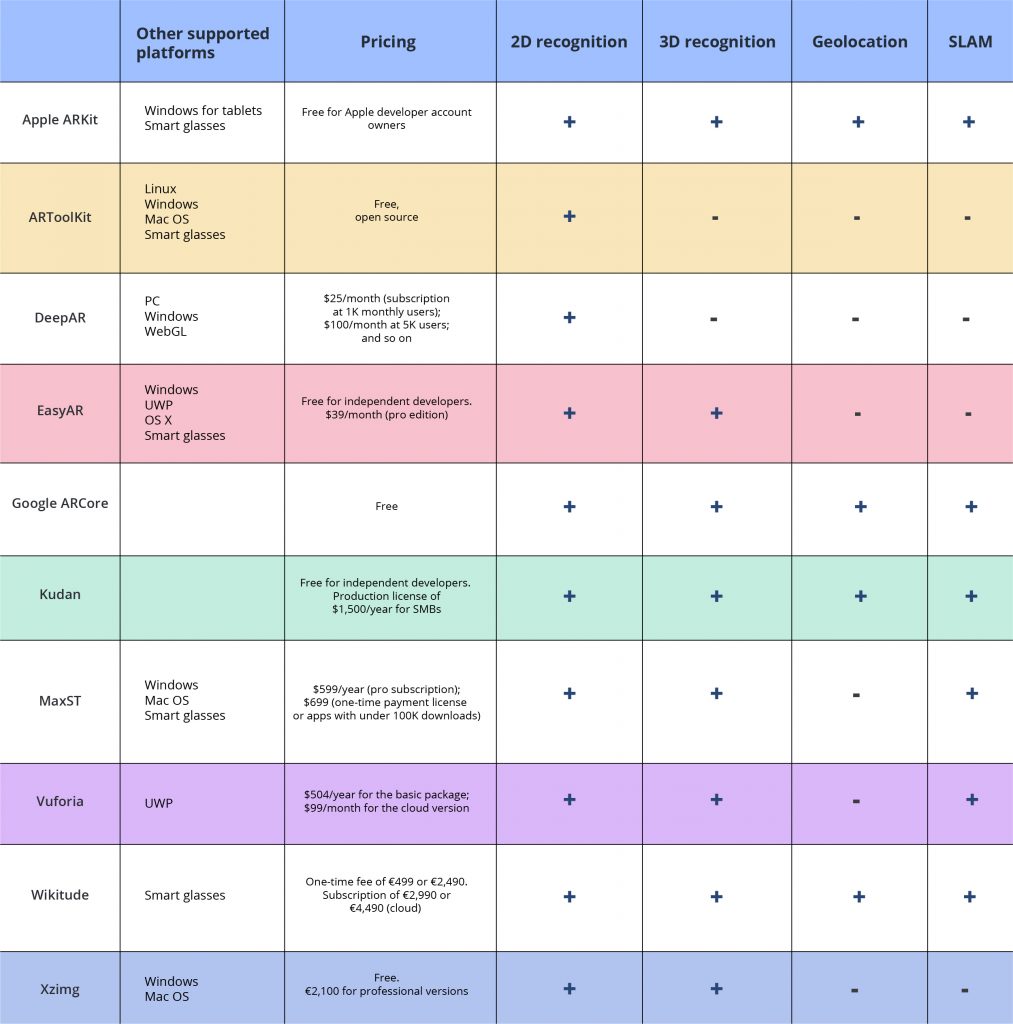
Project Scope
The process of AR app development includes the same stages and factors as any other:
1) Research and business analysis
The first step includes comprehensive research, project requirements elicitation and writing, and planning of the project development. This output affects all subsequent stages.
The first stage might take up to 60-150 hours. It’s possible to save some time and money if some/all of the tasks are completed before the development team is hired.
2) Design of the application and AR content
AR app development involves not only experts in mobile UX/UI design and branding but also 3D artists with image processing skills. Depending on the type of app, they may have to create animated images or 3D models to project on real-world objects or environments. The creation of 3D models includes the development of detailed 3D graphics, which should look as natural and realistic as possible.
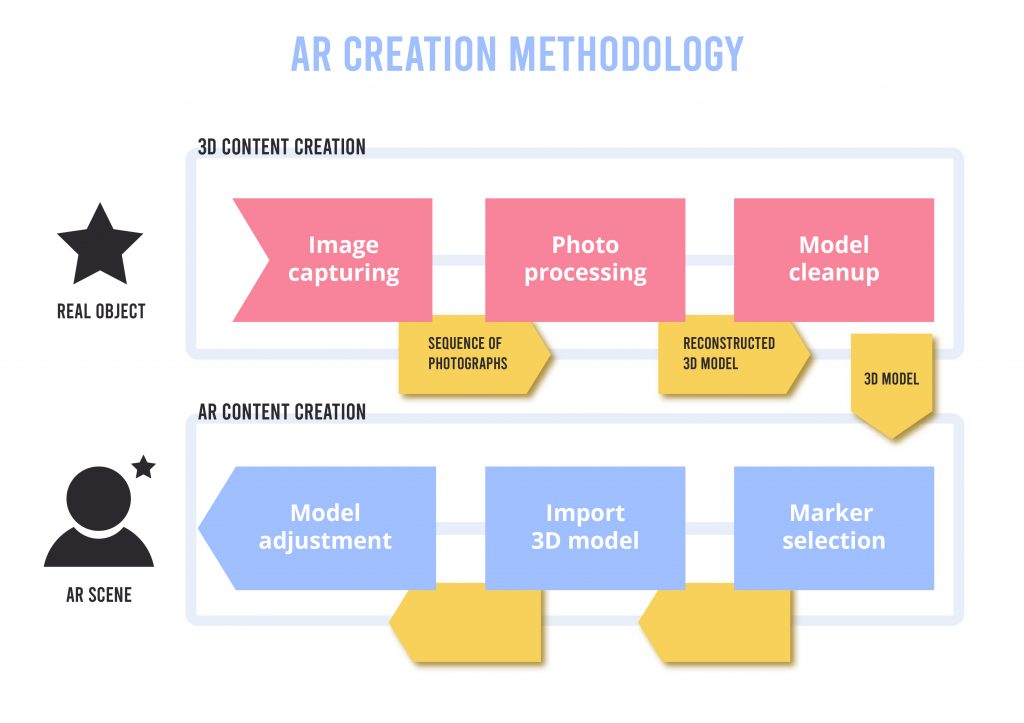
This is the most challenging and time-consuming part of this phase. One good model takes 24 working hours to make, and subsequently 4-5 hours to integrate.
The output of the design phase ideally should include:
- a prototype of the product;
- description of workflows and how the required data and functionality will be arranged within your app;
- the future AR content.
The cost of your mobile app design correlates with how many types of AR content it will offer and the quality of 3D graphics. Depending on that and the app’s complexity, the timeline for design may start at 16 hours for the simplest demo and require over 150 or even up to 600 hours for more complex products.
3) Preparation and planning
Before proper coding, the developers usually need to create the API contract, prioritize tech tasks, choose optimal development tools and practices for the project, or otherwise get prepared for the development of your product. The time needed to plan the software architecture depends on the type of the app and the requested features. The preparation and planning thus may take the team a total of 40-65 hours.
4) Development
The time needed to create an augmented reality app correlates primarily with the number of features to implement. If you have a limited budget, are not sure of your app idea, or wish to test the water before investing in something big, it makes sense to prioritize the desired features for a minimum viable product (MVP). Below is a list of possible essential features.

The back-end development includes API and server implementation and sets up the connections between the mobile app, servers, databases, your website (if any), and third-party services.
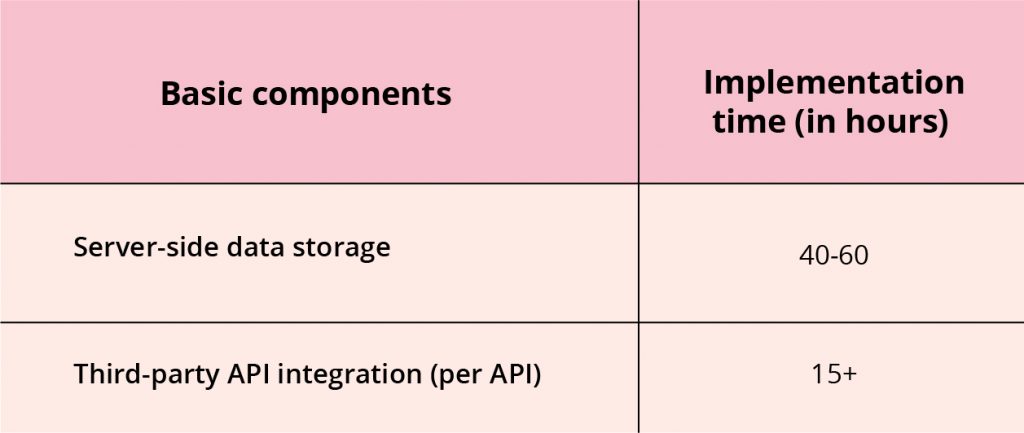
Unfortunately, not every AR-focused mobile app can be launched with only a bare minimum of functions. It takes a more sophisticated application with additional unique features to satisfy both the users’ needs in the real world and the investor’s needs. Below, we have estimated the time needed for implementing some extra features:
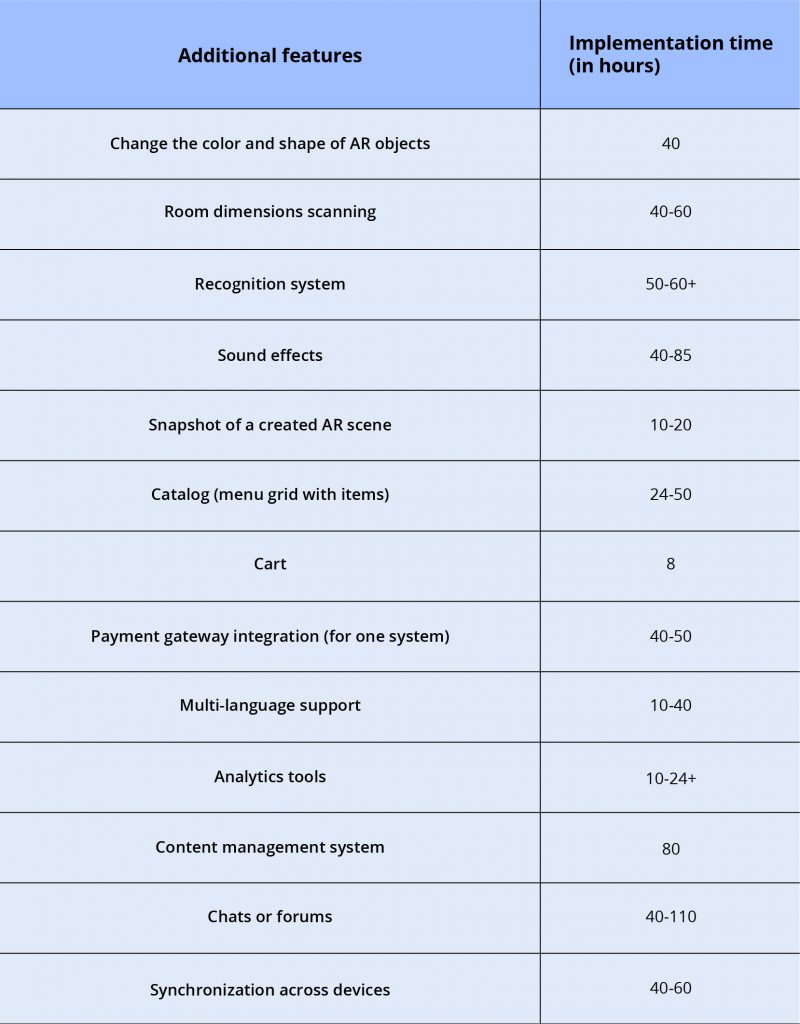
If you are developing a game, the additional features may include:
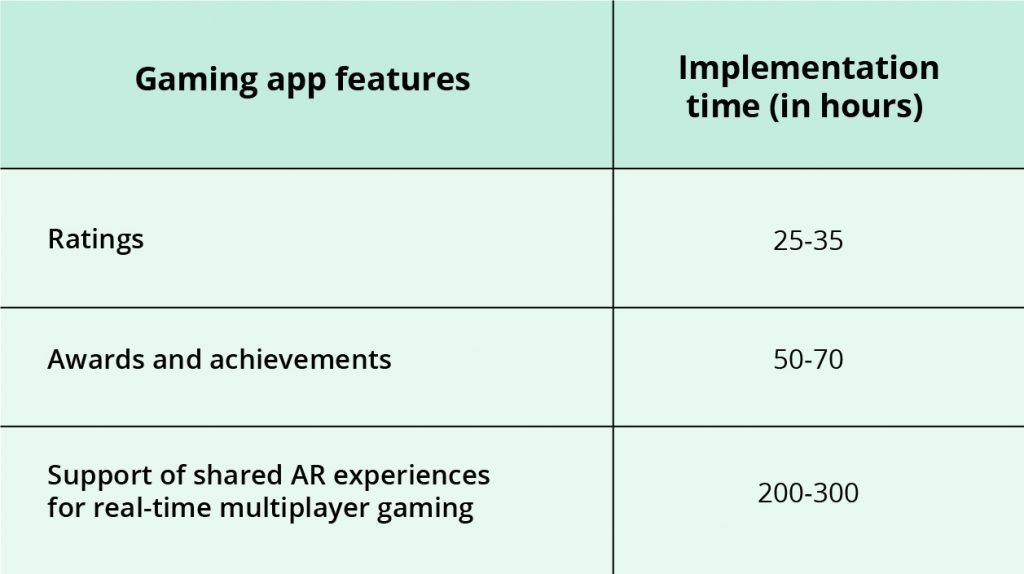
The implementation of technologies required by marker-based/markerless, location-, or SLAM-based applications also belongs to this stage of an AR app development.
5) Quality assurance
Quality assurance will help ensure that your mobile app effectively performs the tasks for end-users, is error-free, and runs smoothly on different devices. QA may take 8-100 hours or account for one-third of the entire app development time.
Once the minimum development time has been estimated, it becomes possible to calculate a budget by multiplying the time by corresponding AR experts’ hourly rates. Here, the best opportunity to save money presents itself.
AR App Development Rates
Your choice of the team impacts your augmented reality app development both in terms of skills and prices. If you want your project to proceed speedily and effectively, you may need at least nine people to cover all aspects of AR app development:
- 1 UX/UI designer
- 1 3D artist
- 3 AR developers
- 2 iOS or Android developers
- 1 QA engineer
- 1 project manager
It takes experienced professionals to create augmented reality apps that will be successful. However, large renowned developer agencies may charge unreasonable fees ‘for the brand,’ and some won’t consider a budget of less than $100,000. It’s wise to shop around, but not to necessarily search for the cheapest freelancers or agencies in the market. Professionals invest their time and money into mastering the necessary skills and constant improvement, so their rates are likely to be higher even in the primary software development outsourcing destinations. It’s crucial to evaluate the candidate’s portfolio, arrange a video conference, and listen to their ideas for developing your app.
Whether it is a website, a regular mobile app, or an application with AR functionalities, often it’s the development team’s location that affects the final cost the most. Digital agencies, small development shops, and freelancers across the globe have dramatically different hourly rates.
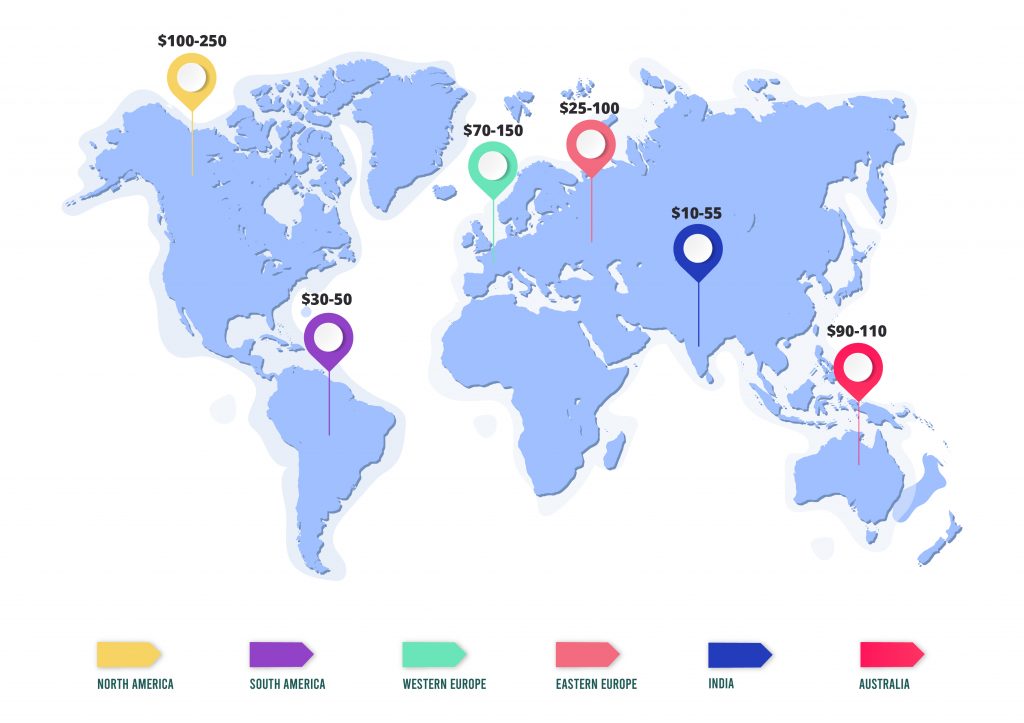
As a result, an app that requires 500 hours to build might cost $50,000 in the US or $10,000 in India.
Additional Factors and Extra Costs
If you need to create your augmented reality app by a certain deadline, you may need to speed up key development processes. Extra developers, designers, and QA staff will cost extra as well.
Most developers will quote only the cost of the mobile app development processes listed above. However, after the publication, the app becomes both a source of revenue and expenditures. Possible overheads may include, but are not limited to:
- payments for functional services (e.g., push notifications, SMS, or email)
- administration, such as the management of app content and users, analytics, etc.
- infrastructure services (servers, data storage, content delivery networks, development tools, libraries and support, and so on)
- ongoing IT support services (regular updates to your app, improvement of its performance and usability, bug fixes, scaling, etc.)
Servers are arguably the costliest item on the list. Most likely, you would choose to be hosted on Amazon Web Services, Google Cloud, Microsoft Azure, or DigitalOcean. The simplest way to calculate the approximate server costs for apps is to estimate the number of app users and the maximum storage capacity for each of them. For example, if the price of storing the object is $0.1 per GB of space per month and there are 5,000 monthly users, with a limit of 2 GB, by multiplying these numbers, you will receive the data storage cost of $1,000/month or $12,000/year. This is a rough estimate, since the number of users may fluctuate, and each user will not necessarily use all the planned space. Experienced developers can adjust the appraisal using their knowledge about the numbers of users on similar apps and their actual use of the server space.
Updates necessary to accommodate iOS, Android, and third-party APIs changes are the second largest expense. The maintenance of the infrastructure (Dev-Ops) may be equal or exceed 20% of the total development budget annually. Bug fixes may account for another 10-20% every year. Moreover, the functional, administrative, infrastructure, and ongoing support expenses will grow exponentially as your app grows.
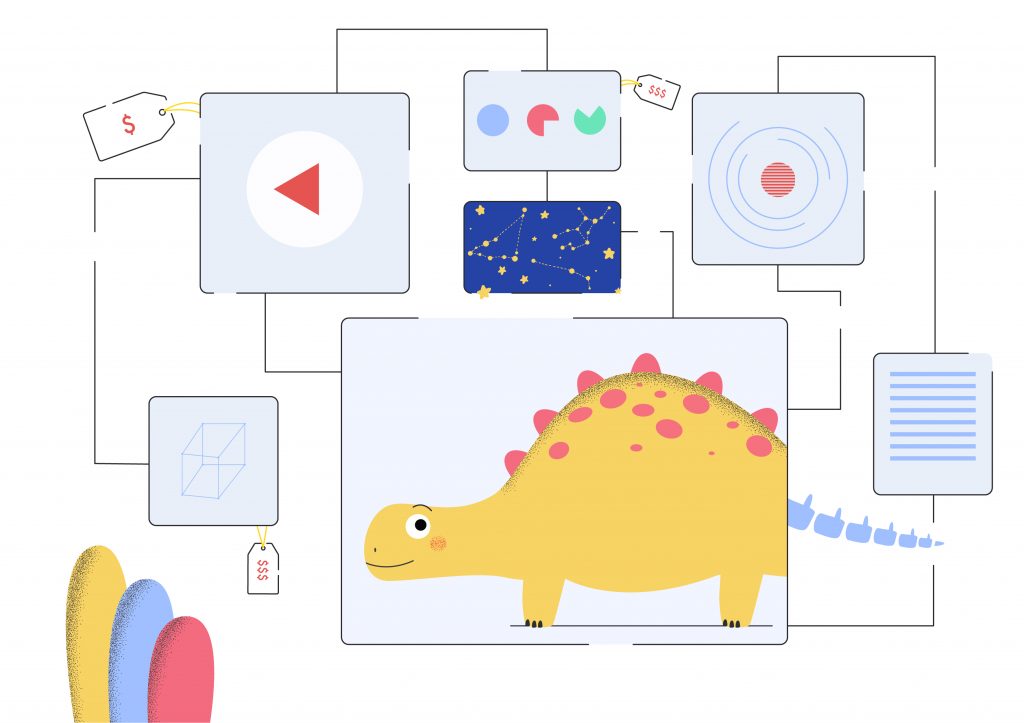
The Bottom Line
Organizations and businesses across many industries have quickly realized the huge benefits that augmented reality and its cousin virtual reality can offer. Particularly, AR technology can help companies of all sizes to
- improve interaction with customers and create an emotional connection with them
- increase customer engagement
- enrich the promotion of services and products
- maximize conversions
- create new revenue streams
- build brand recognition
- increase the efficiency of employees
- improve product quality
… and more. Your AR-enriched product can become your competitive advantage eventually. How much should you pay upfront?
Basically, the augmented reality app development cost may be calculated by multiplying the time to build an app by the developers’ rates. The timeline of mobile app development depends on many factors:
- your business goals
- the type of app to develop
- features you want to implement
- the complexity of the app’s AR content and functionalities
- whether the application is database-based, has a server or API component, etc.
- whether it targets Android, iOS devices, or both
- development team’s competence
- the technologies they use
For example, the time to create augmented reality apps of the following types may be estimated as follows:
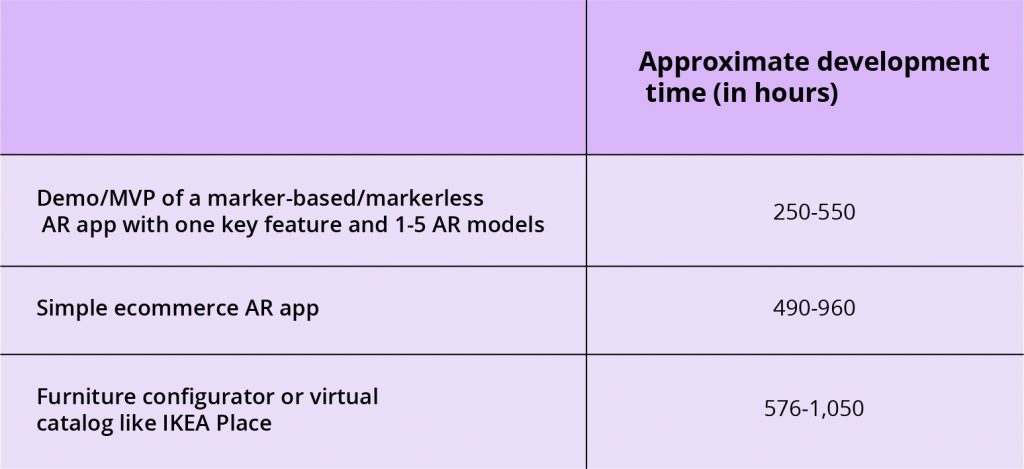
The geographical location of the development agency or team that you contract will have a major impact on the AR app cost. For example, the simplest furniture configurator may cost $31,680 if you hire the most expensive developers in India versus $57,600 in the US or Canada (at the lower local rate).
It’s important to budget subsequent app maintenance, updates, hosting, and other charges as they could surprise you when the time comes. These and other support expenses can annually amount to 20-50% of the initial app development cost.
Before that, you might have a hard time finding skilled and reliable AR and mobile app developers, 3D artists, and UX/UI designers for your project. It is crucial to select a partner that understands your business goals, offers the most relevant solutions, and keeps the promises they make.
Alternative-spaces has broad experience in designing and building mobile applications, including augmented reality apps. If you are looking to create an AR mobile app or game, we will be glad to help.
Content created by our partner, Onix-systems.
 Home
Home